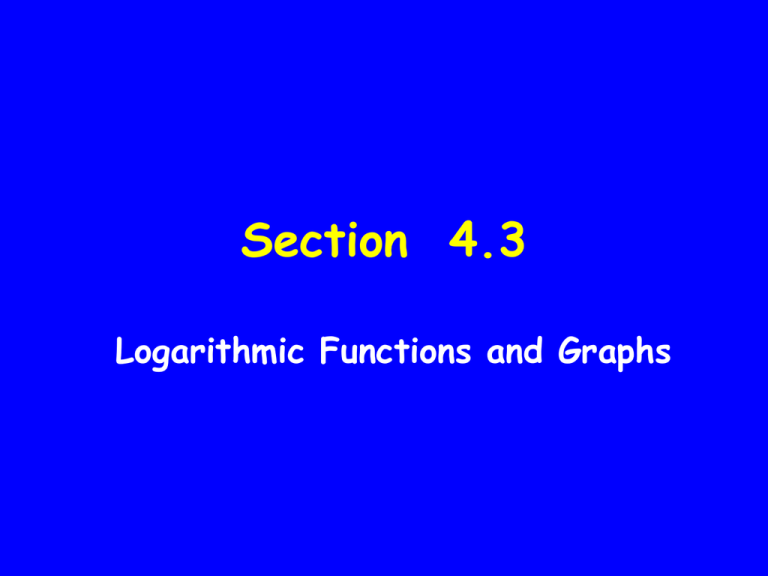Document
advertisement

Section 4.3 Logarithmic Functions and Graphs Flashback Consider the graph of the exponential function y = f(x) = 3x. • Is f(x) one-to-one? • Does f(x) have an inverse that is a function? • Find the inverse. Inverse of y = 3x f (x) = 3x y = 3x x = 3y x = 3y Now, solve for y. y= the power to which 3 must be raised in order to obtain x. x = 3y Solve for y. y= the power to which 3 must be raised in order to obtain x. Symbolically, y = log 3 x “The logarithm, base 3, of x.” Logarithm For all positive numbers a, where a 1, a =x y is equivalent to y = loga x Logax is an exponent to which the base a must be raised to give x. Logarithmic Form loga x y exp onent base Argument (always positive) Exponential Form exp onent y a x ba s e All a log is . . . is an exponent! Logarithmic Functions • Logarithmic functions are inverses of exponential functions. Graph: x = 3y or y = log 3 x 1. Choose values for y. 2. Compute values for x. 3. Plot the points and connect them with a smooth curve. * Note that the curve does not touch or cross the y-axis. Logarithmic Functions continued Graph: x = 3y y = log 3 x x = 3y y (x, y) 1 0 (1, 0) 3 1 (3, 1) 9 2 (9, 2) 1/3 1 (1/3, 1) 1/9 2 (1/9, 2) 1/27 3 (1/27, 3) Side-by-Side Comparison f (x) = 3x f (x) = log 3 x Comparing Exponential and Logarithmic Functions Logarithmic Functions • Remember: Logarithmic functions are inverses of exponential functions. The inverse of f(x) = a is given by f (x) = loga x -1 x Asymptotes • Recall that the horizontal asymptote of the exponential function y = ax is the x-axis. • The vertical asymptote of a logarithmic function y = loga x is the y-axis. Logarithms log a x y x a y A logarithm is an exponent! • Convert each of the following to a logarithmic equation. a) 25 = 5x b) ew = 30 Example • Convert each of the following to an exponential equation. • a) log7 343 = 3 The logarithm is the exponent. log7 343 = 3 7 3 = 343 The base remains the same. b) logb R = 12 Finding Certain Logarithms • Find each of the following. a) log2 16 b) log10 1000 c) log16 4 d) log10 0.001 Common Logarithm Logarithms, base 10, are called common logarithms. For all positive numbers x, logx = log10 x •Log button on your calculator is the common log * Example • Find each of the following common logarithms on a calculator. Round to four decimal places. a) log 723,456 b) log 0.0000245 c) log (4) Function Value Readout Rounded log 723,456 5.859412123 5.8594 log 0.0000245 4.610833916 4.6108 log (4) ERR: nonreal ans Does not exist Natural Logarithms • Logarithms, base e, are called natural logarithms. • The abbreviation “ln” is generally used for natural logarithms. • Thus, ln x means loge x. * ln button on your calculator is the natural log * Example • Find each of the following natural logarithms on a calculator. Round to four decimal places. a) ln 723,456 b) ln 0.0000245 c) ln (4) Function Value Readout Rounded ln 723,456 13.49179501 13.4918 ln 0.0000245 10.61683744 10.6168 ln (4) ERR: nonreal ans Does not exist Changing Logarithmic Bases • The Change-of-Base Formula For any logarithmic bases a and b, and any positive number M, log a M log b M . log a b Use change of base formula when you have a logarithm that is not base 10 or e. Example Find log6 8 using common logarithms. Solution: First, we let a = 10, b = 6, and M = 8. Then we substitute into the change-of-base formula: log10 8 log 6 8 log10 6 1.1606 Example We can also use base e for a conversion. Find log6 8 using natural logarithms. Solution: Substituting e for a, 6 for b and 8 for M, we have log e 8 log 6 8 log e 6 ln 8 1.1606 ln 6 Properties of Logarithms For a > 0, a 1 1. loga a = 1 2. loga 1 = 0 For the logarithmic base e, 3. ln e = 1 4. ln 1 = 0 Graphs of Logarithmic Functions • Graph: y = f(x) = log6 x. – Select y. – Compute x. x, or 6 y 1 6 36 216 1/6 1/36 y 0 1 2 3 1 2 Example • Graph each of the following. • Describe how each graph can be obtained from the graph of y = ln x. • Give the domain and the vertical asymptote of each function. • a) f(x) = ln (x 2) • b) f(x) = 2 ¼ ln x • c) f(x) = |ln (x + 1)| Graph f(x) = ln (x 2) • The graph is a shift 2 units right. • The domain is the set of all real numbers greater than 2. • The line x = 2 is the vertical asymptote. x 2.25 2.5 3 4 5 f(x) 1.386 0.693 0 0.693 1.099 Graph f(x)14 = 2 ¼ ln x • The graph is a vertical shrinking, followed by a reflection across the x-axis, and then a translation up 2 units. • The domain is the set of all positive real numbers. • The y-axis is the vertical asymptote. x 0.1 0.5 1 3 5 f(x) 2.576 2.173 2 1.725 1.598 Graph f(x) = |ln (x + 1)| • The graph is a translation 1 unit to the left. Then the absolute value has the effect of reflecting negative outputs across the x-axis. • The domain is the set of all real numbers greater than 1. • The line x = 1 is the vertical asymptote. x 0.5 0 1 3 6 f(x) 0.693 0 0.693 1.386 1.946 Application: Walking Speed • In a study by psychologists Bornstein and Bornstein, it was found that the average walking speed w, in feet per second, of a person living in a city of population P, in thousands, is given by the function w(P) = 0.37 ln P + 0.05. Application: Walking Speed continued The population of Philadelphia, Pennsylvania, is 1,517,600. Find the average walking speed of people living in Philadelphia. Since 1,517,600 = 1517.6 thousand, we substitute 1517.6 for P, since P is in thousands: w(1517.6) = 0.37 ln 1517.6 + 0.05 2.8 ft/sec. The average walking speed of people living in Philadelphia is about 2.8 ft/sec.





